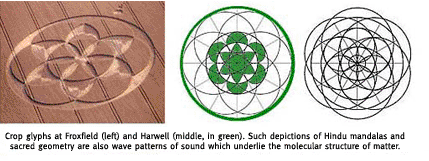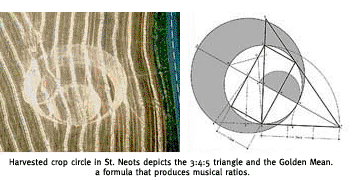via: The Crop Circular
Extracts from Secrets in the Fields © Freddy Silva, 1997, 2002.
Images © Freddy Silva, Lucy Pringle, Colin Andrews. Cymatics images from Cymatics: A Study of Wave
Phenomena and Vibration by Hans Jenny.
© 2001 Macromedia, and courtesy of Jeff Volk.
To date some 10,000 crop circles have been catalogued worldwide, and their anomalous features continue to be irreplecatable: plants bent an inch above soil and gently laid down in geometrically-precise patterns with no physical signs of damage, light burn marks at the base of stems, altered cellular structure and soil chemistry, discrepancies in background radiation, alteration of the local electromagnetic field, depletion of the local watershed, and dowsable, long-lasting energy patterns, not to mention measured effects on the human biological field. So much, then, for two guys and a piece of wood. But thanks to a virtual embargo on research coverage throughout the media, a popular myth has developed that all crop circles have been nothing more than a prank with a plank.
 By definition, hoaxes are forgeries, and forgeries require originals from which to copy. So what is this 'unknown force' that creates genuine crop circles? One answer may lie with sound.
By definition, hoaxes are forgeries, and forgeries require originals from which to copy. So what is this 'unknown force' that creates genuine crop circles? One answer may lie with sound.
Echoed in all the world's faiths and traditions, Universal matter was created by sound: 'In the beginning was the Word, and the Word was with God', St. John reminds us. Hopi and Navajo traditions even assert that in ancient times shamans would utter words onto sand and create patterns, a concept not dissimilar to the Hindu mandalas which are said to be expressions of the vibration of God. Consequently, the Eastern faiths- Islam in particular- chose sacred geometry to express the image of God, a technique later used in those hymns to sacred geometry, Gothic cathedrals.
attribut edModern science now shows that these geometric rhythms lie at the centre of atomic structures. When Andrew Gladzewski carried out research into atomic patterns, plants, crystals and harmonics in music he concluded that atoms are harmonic resonators, proving that physical reality is actually governed by geometric arrays based on sound frequencies. Even that primeval Hindu sound, the OM, from which is derived our modern term 'hum', when sung into a tonoscope produces the very geometric shapes attribut with 'sacredness'. Perhaps the most important of these shapes is the hexagon, upon which the Egyptian matrix named the Flower of Life is based. This series of outwardly-rotating divisions of the circle accommodate the branches of the building blocks of life, the amino acids. This Flower of Life has subsequently manifested as a crop circle.
edModern science now shows that these geometric rhythms lie at the centre of atomic structures. When Andrew Gladzewski carried out research into atomic patterns, plants, crystals and harmonics in music he concluded that atoms are harmonic resonators, proving that physical reality is actually governed by geometric arrays based on sound frequencies. Even that primeval Hindu sound, the OM, from which is derived our modern term 'hum', when sung into a tonoscope produces the very geometric shapes attribut with 'sacredness'. Perhaps the most important of these shapes is the hexagon, upon which the Egyptian matrix named the Flower of Life is based. This series of outwardly-rotating divisions of the circle accommodate the branches of the building blocks of life, the amino acids. This Flower of Life has subsequently manifested as a crop circle.
As the expression of number in space, geometry is inextricably linked to music since the laws of the former govern the mathematical intervals that make up the notes in the western music scale- the diatonic ratios- hence why the ancient Egyptians referred to geometry as frozen music.
In the February 1992 edition of Science News, Prof. Gerald Hawkins used the principles of Euclidean geometry to prove that four theorems can be derived from the relationships of elements in crop circles. More significantly, he discovered a fifth theorem from which he could derive the other four. Despite an open challenge, over half a million subscribers have been unable to create such a theorem, which Euclid himself only hinted at twenty-three centuries earlier in his thirteen treatises on mathematics. So it came as a slight surprise when its equilateral version materialized as 160,000 sq. ft. of flattened barley at Litchfield, Hampshire.
Since Hawkins' Euclidean theorems also produce diatonic ratios, a link exists between crop circles and musical notes, themselves the by-product of the harmonic laws of sound frequency. Soon, crop circles bearing unmistakable associations with sound then began to appear. One contained a curious ratchet feature from which is constructed a musical diagram also dating to the Egyptians, the Lambdoma. Also known as the Pythagorean Table, it defines the exact relationships between musical harmonics and mathematical ratios.
In 1996 another crop circle demonstrated the combination of two important figures: the 3-4-5 triangle and the Golden Mean, producing the geometric diagram necessary to produce musical ratios. But it was a convincing formation at Goodwood Clatford- which had its plants bent six inches from the top- that gave the proverbial nod to sound, for here was a representation of a cymatic pattern etched in 5000 sq ft of barley.
Cymatics is the study of vibrational wave patterns. One of its earliest pupils was Margaret Watts-Hughes who, in 1891, captured precise geometric patterns on film as she sang sustained notes into a device containing  lycopodium powder. But it would be another seventy six years before Swiss scientist Hans Jenny published the first of his painstaking studies on the transmission of sound through physical mediums, this time in the shape of monitored electronic frequencies.
lycopodium powder. But it would be another seventy six years before Swiss scientist Hans Jenny published the first of his painstaking studies on the transmission of sound through physical mediums, this time in the shape of monitored electronic frequencies.
He observed how sound vibration created geometric shapes- a low frequency produced a simple circle encompassed by rings, whereas a higher frequency increased the number of concentric rings around a central circle. As the frequencies rose so, too, did the complexity of shapes, to the point where tetrahedrons, mandalas and other sacred forms could be discerned.
...so far the connection with sound and
the creation of crop circles is my favorite.When you think of sound as vibration, light
as vibrating, even molecular structure
as vibrating, consciousness...are WE as ONE
creating these images trough vibration
via our collective consciousness ??looking at the formations
and evidence of construction...
seems to me, as they were
created by nature.
OUR nature
plz share any of your
thoughts, knowledge, resources ect.
THNX!
...peace--
